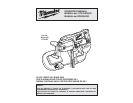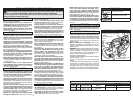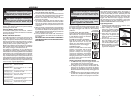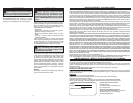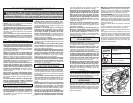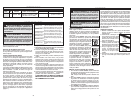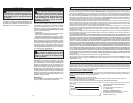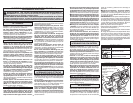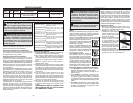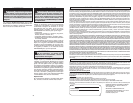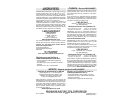
4
5
6 Teeth per Inch
8 Teeth per Inch
10 Teeth per Inch
14 Teeth per Inch
18 Teeth per Inch
24 Teeth per Inch
OPERATION
WARNING To reduce the risk of injury,
keep hands away from the blade and
other moving parts. Always wear safety
goggles or glasses with side shields.
WARNING Always remove battery
pack before changing or removing ac-
cessories. Only use accessories specifi cally
recommended for this tool. Others may be
hazardous.
High/Low/Trigger Lock Switch
To set the maximum speed or lock the trigger, allow
the motor to come to a complete stop then move
the high/low/trigger lock switch to the following
positions:
For low speed (Max 225 SFPM):
Push in the control switch from the left
side of the tool. To vary the speed up
to 225 SFPM, increase or decrease
pressure on the trigger.
For high speed (Max 350 SFPM):
Push in the control switch from the
right side of the tool. To vary the
speed up to 350 SFPM, increase or
decrease pressure on the trigger.
To lock the trigger:
Push the control switch to the center
position. The trigger will not work
while the switch is in the locked
position. Always lock the trigger
and remove the battery pack before
performing maintenance and when
changing accessories. Lock the trig-
ger when storing the tool and when
the tool is not in use.
Starting, Stopping and Controlling Speed
1. To start the tool, grasp the trigger handle and
front handle fi rmly and pull the trigger.
Note: LED turns on when the trigger is pulled.
2. To vary the speed, increase or decrease the
pressure on the trigger. The further the trigger
is pulled, the greater the speed. The maximum
SFPM is determined by the high/low/trigger lock
switch.
3. To stop the tool, release the trigger. Allow the tool
to come to a complete stop before removing the
blade from a partial cut or laying the tool down.
Low Speed
Max 225 SFPM
High Speed
Max 350 SFPM
Trigger
Lock
Incorrect
Correct
• For tough stock 1/2" to 3-3/8" in
diameter or width.
• For tough stock 3/8" to 1" in diam-
eter or width.
• For tough stock 3/16" up to 4-3/4"
in diameter or width.
• For tough stock 5/32" to 3/4" in
diameter or width.
• For thin-wall tubing and thin sheets
heavier than 21 gauge.
• For thin-wall tubing and thin sheets
heavier than 21 gauge.
Changing Blades
1. REMOVE BATTERY PACK BEFORE CHANG-
ING OR REMOVING BLADES.
2. Turn the tension lock handle located on the front
of the saw 180° counterclockwise. This releases
the tension on the blade for easy removal.
3. Remove the blades from the pulleys fi rst and
then from the guides.
4. To install a new blade, with the pulleys facing
up, insert the blade between the rollers and the
faces of the guides, making sure that the teeth
on the left side of the tool point towards the rear
of the tool.
5. With one hand, hold the blade in place between
the rollers and the guides and use the other hand
to position the blade around the pulleys. Be sure
that the blade lies freely within the guard channel
before starting the tool motor.
6. Turn the tension lock handle 180° clockwise to
lock the position. This will secure the blade on
the pulleys.
BE SURE THAT THE BLADE IS PROPERLY
SEATED ON THE PULLEYS BEFORE START-
ING THE CUT.
Electric Brake
The electric brake engages when the trigger is
released, causing the blade to stop and allowing
you to proceed with your work. Generally, the saw
blade stops within two seconds. However, there
may be a delay between the time you release the
trigger and when the brake engages. Occasion-
ally the brake may miss completely. If the brake
misses frequently, the saw needs servicing by an
authorized MILWAUKEE service facility.
Typical Application
1. Keep the blade off the workpiece until the motor
has reached the selected speed.
2. Start cutting on a surface
where the greatest number
of teeth will be in contact with
the workpiece at one time.
3. Place the work steady rest
against the workpiece and
lower the moving saw blade
into the cut.
4. Do not bear down while cut-
ting. The weight of the tool
will supply adequate pres-
sure for the fastest cutting.
5. When completing a cut, hold
the tool fi rmly so it will not fall
against the workpiece.
ASSEMBLY
WARNING Recharge only with the char-
ger specifi ed for the battery. For specifi c
charging instructions, read the operator’s man-
ual supplied with your charger and battery.
Removing Battery Pack from Tool
Push in the release buttons and pull the battery
pack away from the tool.
Inserting Battery Pack into Tool
To insert the battery pack onto the tool, slide the
pack onto the body of the tool. Make sure it latches
securely into place.
Blades and Blade Selection
The blade dimensions required for the band saws
are: .020" thickness, 1/2" width and 44-7/8" in
length. The special .020" thickness reduces fl exure
fatigue and provides maximum tooth life. To maxi-
mize cutting life, use a blade with the correct pitch
(teeth per inch) for the specifi c cutting job.
Blades are available in several pitches. To select the
proper blade, three factors should be considered:
size, shape, and type of material to be cut.
The following suggestions are for selecting the
right blade for various cutting operations. Keep in
mind that these are broad guidelines and that blade
requirements may vary depending upon the specifi c
size, shape and type of material to be cut. Gener-
ally, soft materials require coarse pitch blades and
hard materials require fi ne pitch blades. Use coarse
pitch blades for thick work and fi ne pitch blades for
thin work. It is important to keep at least three teeth
in the cut (see "Typical Application").
WARNING Always remove battery
pack before changing or removing ac-
cessories. Only use accessories specifi cally
recommended for this tool. Others may be
hazardous.



